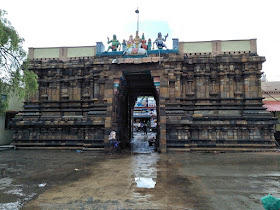Adi Kumbeswarar Temple, Kumbakonam – The Temple
The Temple is the largest Shiva Temple of Kumbakonam. It is facing towards east with 9 tiered Rajagopuram (gateway tower). The Rajagopuram is about 128 ft tall. Kumbeswarar temple complex covers an area of 30,181 sq. ft (2,803.9 m2) and houses four gateway towers known as gopurams. There is a 3 tier second level Rajagopuram. There is an unfinished main tower (Rajagopuram) here which is called Mottai gopuram. This is a well-known land mark of the temple.
The temple has 3 corridors, elongated along an east-west axis has triple set of gopurams. The temple is approached by a corridor 330 ft (100 m) long and 15 ft (4.6 m) wide. The flag mast is located in the second precinct, directly on the axis of the presiding deity. Beyond the flagstaff, a hallway whose columns feature painted brackets representing Yali (a mythological creature) leads to the gopuram.
Nandi and Bali Peetham can be found facing the sanctum in the inner prakaram. The sanctum sanctorum consists of Sanctum, Antarala, Artha Mandapam and Maha Mandapam. Presiding Deity is called as Adi Kumbeswarar / Amutheswarar and is facing east. The central shrine (sanctum) of the temple houses the image of Adi Kumbeswarar in the form of lingam. It is believed that Linga had been made by Lord Shiva himself when he mixed nectar of immortality and sand.
The base of the Linga is broad at the bottom and narrow at the top as a needle point. Since the lingam is made of sand, the abhishekam is performed only to the base (Avudayar). Only Punugu (civet) is applied to the lingam once in a while. The lingam is big in size (Mahalingam) and it is in an inclined position. It is always covered with gold sheets (Kavasam).
Mother is called as Manthra Peeteswari / Mangalambikai / Mantra Peeta Nalathal. She is housed in a separate south facing shrine. Her shrine is situated parallel to the left of Kumbeswarar Shrine and Somaskanda is located to the right. She wears the yellow sari with turmeric on the face and the Kumkum on the forehead. She glitters with all mercy.
The temple complex houses many halls; the most notable is the sixteen-pillared hall built during the Vijayanagar period, Navaratri Mandapam. Navaratri Mandapam (Hall of Navratri celebration) has 27 stars and 12 Rasis (constellations) carved in a single block. The temple has a colonnaded hall and a good collection of silver vahanas (sacred vehicles used to carry deities during festival processions). The temple is in possession of two granite Nadaswarams (a musical instrument).
A lion carrying some stones on head in the front hall of the temple stands as an example of the Tamil sculpture art. There is a separate shrine for Lord Kirata Murthy / Vetta Murthy. This is unique to this temple as it commemorates the legend that Lord Shiva himself reinstated life back on earth. Kumbamuni Siddhar Shrine is situated in the outer corridor of the temple. Devotees pray here for relief from the adverse aspects of planets.
Lord Vinayaka of the temple is praised as Aadhi Vinayaka. There is an idol of Govinda Dikshitar and his wife Nagammal in the Temple premises. There is a shrine for Lord Murugan called Karthikeyan here. The uniqueness of this lord’s idol is that he is seen with his consorts and his peacock mount. He is depicted with six faces but with only 6 hands instead of 12.
There are shrines and idols of Vinayakar, Murugan, Gajalakshmi, 63 Nayanmars (both stone and procession idols), Nataraja, Somaskandar, Kirata Murthy, Nalvars, Virabhadrar, Sapta Kannikas, Visvanathar with Visalakshi, Valam Chuzhi Vinayakar, Dakshinamurthy, Brahma, Vishnu, Bikshadana, Arukala Vinayakar, Sabha Vinayaka, Annapoorani, Mahalakshmi, Saraswathi, Jeshta Devi, Durgai and Chandikeswarar in the first prakaram.
There are shrines and idols of Navaneetha Vinayakar, Sattainathar, Bhairavar, Jwarahareswarar, Chandran, Suryan, Vallabha Ganapathi, Navagrahas, Adhikara Mandi, Lakshmi Narayana Perumal, Vanni Vinayakar, Mutra Veli Vinayaka, Bala Dhandayudhapani, Kumarappar, Adhi Linga and Kumbha Muni Siddhar in the second prakaram. Chamber of repose, decoration hall, Sacrificial hall, grand kitchen, marriage hall, elephant shed, Vasanthamandapam, cattle shed, garden and four-pillared hall are other notable parts in the temple.
The Car Street is beyond the outermost wall and festive processions with the deities in the special chariots are taken on this route. On either side of the eastern Rajagopuram there are bazaars and the shed that houses the chariot. There are five silver-plated chariots in the temple used to carry the temple deities during festive occasions. Sthala Vriksham is Vanni Tree.
The Mahamaham tank, Potraamarai Tirtha, Varuna Tirtha, Kashyapa Tirtha, Chakkara Tirtha, Matanga Tirtha and Bhagavad Tirtha (bathing Ghats along the river Cauvery) are the seven outlying water bodies associated with the temple. Mangala Kupam Asva, Naga tirtha, Kura tirtha are the three wells, while Chandra tirtha, Surya tirtha, Gautama tirtha and Varaha tirtha are the four tanks located inside the temple.
The Potramarai tank (tank with golden lotus flowers) is situated in front of the temple. The Potramarai tank separates the Kumbeswarar temple from Sarangapani temple. Those visiting the temple during the Mahamagam festival (famous festival celebrated once in 12 years as the Kumbh Mela in North) take bath in the tank.












